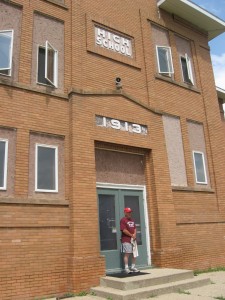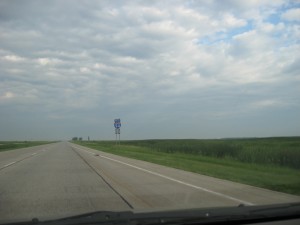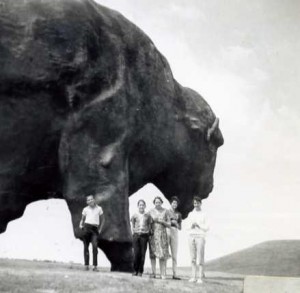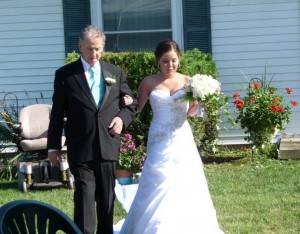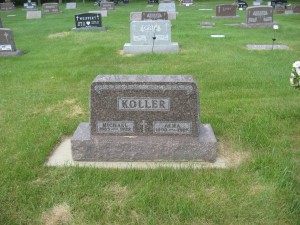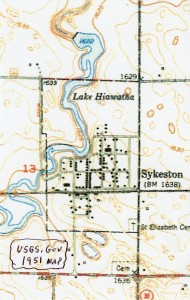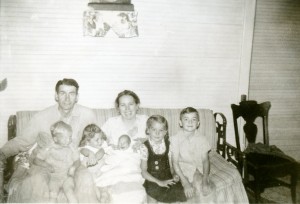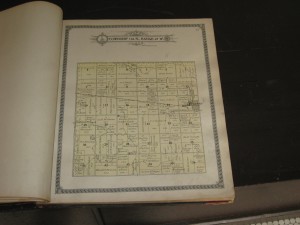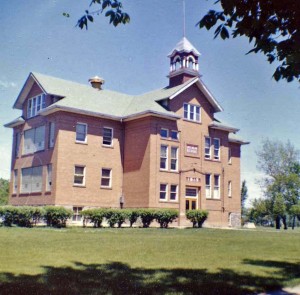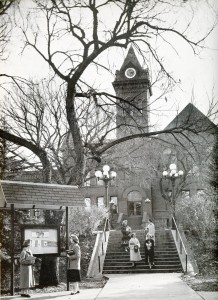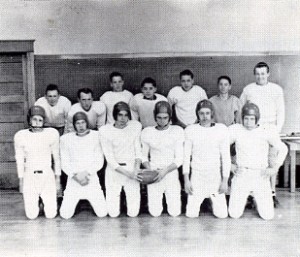See Update from Carl Peter at end of this post.
Going through some old photographs recently I came across this one of Louis Bruhn, taken by my father in May, 1974, at a Valley City State Teachers College alumni gathering in Anoka, Minnesota. (click to enlarge).
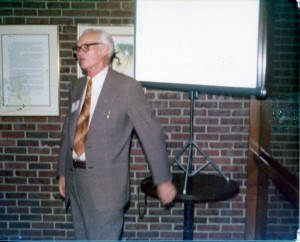
I lived in rural Anoka at the time, and I remember my parents visit but not this specific event, though I’m sure I was there.
Both of my parents were graduates of what we called, then, VCSTC, Valley City State Teachers College. I graduated from there myself. Just this morning I mailed my annual small donation to the now-VCSU Foundation. A pleasant sounding student called me a few nights ago just to renew my acquaintance with my alma mater.
Colleges know how to keep in touch with their alumni!
Mr. Bruhn – that’s what we all would have called him – was Dean of Men and Director of Special Services at the tiny 700 or so student college in 1958-61 when I was a student there.

Two very important mentors: Lou Bruhn, and Mary Hagen Canine, pictured in the 1959 Viking Annual of Valley City State Teachers College
He seemed terribly old at the time, but through the miracle of the internet (which he could not have imagined then), he was apparently only 55 when I first darkened the college doors in the Summer of 1958.
Here’s what someone wrote about him in 1976.
He was 71 when Dad took the above photo. GASP. That’s how old I am, now!
The bio says that Mr. Bruhn came to VCSTC in 1938 to teach Business courses.
My parents, Henry L. Bernard of Grafton and Esther Busch of rural Berlin, had both matriculated at the college, probably in the summer of 1929, and like legions of country school teachers of the time they would teach school during the school year, then come back to college in the summer. They are both long deceased, but left behind many stories. They met in the halls of VCSTC, married in 1937, then taught together at Amidon ND during 1937-39. Most likely they were back at Valley City in the Summer of 1938 when Mr. Bruhn arrived.
During 1939-40 Dad became a full-time, full-year student at the college – the only full year he ever spent in college – and he received his degree a few weeks after I was born. They lived, that year, in the McGillivray Apartments just off campus, right behind what became Cinks College Grocery (and what is now the Valley City State University Student Center – which was actively being planned in 1961). For over 30 more years they remained in public education, Mom taking a few years off to raise us younguns to school age.
Dad most likely got to know Mr. Bruhn fairly well. They were, after all, about the same age. Eighteen years later, in 1958, it was my turn to do something with my life after graduating from Sykeston High School.
Truth be told, for this lazy kid in the summer of 1958, college summer school looked far better to me than wrestling a wheelbarrow full of dirt at the under construction St. Elizabeth’s Church in Sykeston. So, off I went. My mother went as well, to Summer School.
College caught on, and I went straight through, graduating 50 years ago last December. Those were memorable years.
Small colleges like VCSTC certainly don’t have the reputation of big or prestigious institutions, but I’m here to say, loudly and proudly, that with folks around like Louis H. Bruhn, we country kids from tiny high schools not only got a solid college education, but we left well prepared for life, accompanied by a strong work ethic.
The biography does not list a date of death for Mr. Bruhn, though I’d doubt he’s still with us. Doubtless someone will let me know details posthaste (you can comment on this post – see tab below).
Thanks Mr. Bruhn, Mom, Dad, and everyone who saw me and legions of fellow students through the growing experience from post high-school to college graduation.
Thanks once again.
from Shirley Bruhn Lindsay (Lou and Mabel Bruhns daughter, received Mar. 9, 2012): It is with an overflowing heart that I reply to you re the messages about my dad, Lou Bruhn. It is such a lovely tribute to him – a man who loved people (especially the students) and the town of Valley City more than he could ever really express. He served on the City Commission for several years and ultimately served as Mayor. A fond memory for our family is of the “Lou Bruhn Day” the city declared when he retired as Mayor.
My dad died late October 1988. He and my mother, Mabel, moved to the Sheyenne Care Center (SCC) several years earlier after she suffered a severe stroke. They had a wonderful quality of life in SCC and continued their enjoyment of people in the town they both loved.
Thank you for these tributes and memories. I have shared them with my brother Dave’s family.
My parents moved to VC in 1938 to “try it out for a few years”…they never left. Isn’t that a tribute to the town and state of North Dakota?
UPDATES: MARCH 8
From Valley City State University Alumni Association via Facebook: Dick – thank you for sharing this post. We enjoyed reading it. Looking at our records it looks like Lou passed away in the late 80’s.
Bob Zimmerman, Fayetteville AR: It’s good to hear from you again, Dick! It’s okay if you and others want to send e-mail to me at: BobzATuark.edu. Lois Nunn Zimmerman and I willl be married 50 years on June 3, 2012. We [recently] were vacationing at South Padre Island, TX. I met Myron (Ike) Luttschwager there for lunch. I will be retiring from my position as Associate Vice Chancellor for IT at the University of Arkansas on June 30, 2012. We hope to spend some time in SD, ND, and MN this summer. Best wisher to all! Lois and Bob
I had a recent letter from Bob and Marge Nutz Sogn. Bob and Marge Sogn sent pictures with David Thielman and his new wife. The Sogns live in Tuscon, AZ. Dave lives in Palm Springs, CA, in the winter. I have not seen Dave and Bob for many years and I hope to find them and some other long lost pals again. Bob
Lois and I had a conversation with Bob and Deann Horne about a month ago. They have moved to Fargo from Minot. Their home in Minot was severely damaged by the floods in Minot. We will visit my brother, Allan Zimmerman and his wife, Carol Schmidtz Zimmerman in Fargo. Buddy Schmidtz is a brother to Carol.
Duane Zwinger, Carrington, class of ’64: It was sure enjoyable reading your recollections about VCSTC and “Mr. Bruhn”. I truly agree with your statement that “tiny” Valley City State Teachers College
gave us all a great start in making our small mark on this great big world. The email also brought back some memories of myself and some of my hooligan buddies having a “close encounter” with Mr. Bruhn. We really didn’t mean to get into trouble, but it did seem to find us.
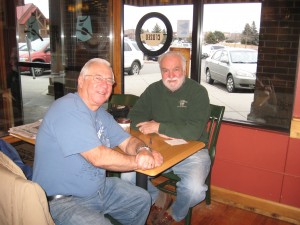
Duane Zwinger and Dick Bernard, February 2012, at Woodbury MN
: Got your email. I remember the dean well. He was also a sought after square dance caller. One cold winter evening he called a square dance in my home town of Kathryn. When the dance was over there was a full blown blizzard outside Some of the dancers and Lou Bruhn came to my parents store (we lived in the back) and the square dance continued in the store. As I recalled all spent most if not all of the night with us.
Larry Gauper, Fargo ND: Dick…YES…I remember Lou Bruhn…one of those classic Valley City college names
Wes Anderson, Valley City ND: We have about three audio interviews with Lou in our collection from Don Welch
Colleen Zick: I don’t know if you knew, but he also repaired bicycles. He made mine like new! I remember him and his wife well. Thelma Acker lived right next door to him, and she always cut and permed my hair! Her daughter married Eldwin VanBruggen, Gladys’s brother. The VanBruggens were my next door neighbors.
Larry Gauper: I remember that…and I think he was a ham radio guy too..not sure about that…but do remember now that you mention it the bike repair thing….neat fellow and apparently a great teacher.
Bob Horne, Fargo: Thanks for the Photo of Lou Bruhn, your excellent comments, and ideas added by others.
We remember Mr. Bruhn with fondness; he was a great guy and a friend to students. Also, I knew his son David quite well, as I believe we played Legion baseball together the summer of 1953, between my freshman and sophomore HS years. That summer I stayed with my aunt, Charlotte Graichen, before returning to Edmore HS. You probably know that Charlotte taught at VC State for about 30 years; they named the women’s gym after her. Charlotte and Bill Osmon were long-time leaders of women’s and men’s athletics at VC State Teachers College.
Dick Bernard: The phrase “comfortable as an old shoe” now comes to mind with respect to Mr. Bruhn – but make no mistake, he was MR. Bruhn. As for Charlotte Graichen and Willis Osmon, I came to VCSTC with the idea that basketball would be fun. Things change. I’m guessing that one of the last credits on my transcript was for some required PE class I had neglected to take, and Ms. Graichen was the instructor at the women’s gym. In the spring of 1961, they were just completing the impressive athletic building just west of the campus, I think still named for Mr. Osmon, and I think I’ll dig out my old set of Viking News and scan the photo of me with the under-construction building.
Roger Taylor: I remember Lou Bruhn well. The Bruhn family lived across the street from my childhood home. He did repair bicycles, but not mine, my dad did that. They had a post at the end of their driveway on which they’d installed a backboard and hoop. It was one of the several hoops in our neighborhood which we used, probably the best as the hoop was regulation height and the playing area was flat (most driveways had slants which meant the basket had varying heights relative to the player’s position on the “court”). The Bruhns had two children I remember, a girl named “Shirley” and a boy whose name I don’t remember. They were at least four years older than we. The article also references Cink’s grocery store. That’s another place in which I spent a fair amount of time. But it wasn’t our primary local grocery. That one was on College Street about four doors down from the Bruhn home.
UPDATE March 9, 2012
Dick Bernard: This link
Viking News Jul 61 Union001, from the July 5, 1961 Viking News (the college newspaper) shows the site of the to-be college Student Union, including part of Cink’s grocery, and the still under construction Physical Education building which was, in 1961, ‘state of the art’. In the photo, I’m the guy standing by the support beam. For some reason related to the times, I dressed up for the photo.
Ron Morsch: Boy, that’s a name out of the past. I knew the name right away, could faintly picture who it was but even after reading Dick’s post couldn’t recall anything specific. I think Beth is right about Kiwanis or maybe Elks or Toastmasters. My dad was active in them and maybe that’s why I know the name. The bicycle repair stuff also prompted a faint memory of my Dad and me being in his garage having something done to my bike, but I’m not sure.
Barb Lang: Mr. Bruhn’s daughter Shirley is living in Lake Forest, IL and my sister Mary sees her every now and then for coffee. Mary also thinks that possibly Mr. Bruhn was Mayor at some point . . .that’s her vague recollection! Mary notes that Shirley has a Facebook page (my sister is a big looker at Facebook).
Rhea Mills: Has been interesting listening to all the other comments on Mr. Bruhn. Having lived on the “north” side of the tracks, there are a lot of things I had never heard of that occurred on the “south” side of the tracks. I know a lot of names but I really can’t remember things about those names – if, indeed, I even knew those things in the first place – HMMMMM, that is one run on sentence that really doesn’t make much sense except to myself!
Dick Bernard: Of course, in Valley City, at that time, when you’d say “north side of the tracks”, the question would have to be “which tracks?” North of the Hiline, or north of the tracks downtown (or uptown? : – ) NP or Soo Line, or whatever the two railroads were. (My parents did the walk across the Hiline in the 1930s, I think. I never dared.)
I was born at Mercy Hospital in May, 1940, and probably lived in the very tiny McGillivray apartment (Dad once showed it to me – it was vacant at the time, basement, the side away from the college) for perhaps a month or two, then we moved to Rutland area.
I didn’t own or have access to a car during the college years. My ‘territory’ was virtually 100% walking. Farthest north was to St. Cate’s for church on Sunday. Otherwise downtown to Pillar or Omwick where I worked; or Mythaler Hall to the halls of STC…. An aunt and uncle lived in the St. Mary’s of Dazey community but it was real rare to see them out there. The first ND section of I-94 was built between Jamestown and Valley City during the time I was there – “a million dollars a mile” they said. My family lived in Sykeston, northwest of Jamestown, and while I seldom went back there once I started, I can remember driving that freeway including a portion that did not yet have completed shoulders.
The STC of my memory was something like an ant hill, full of activity and a community unto itself, small as it was. Having graduated with 9 colleague seniors, and gone to several other ND public schools which were even smaller, the college was immense. My roommate for three years at Mythaler, a kid from Wimbledon, is a retired teacher in a city high school in St. Paul, and he once told me that for we tiny town kids, VCSTC was much like high school experience for kids in much bigger towns (including Valley City). We came from places that might have three high school teachers, at most, and we got the basics: “Reading, ‘Ritin, ‘Rithmetic” and the occasional ‘hickory stick’ (a”likkin”). Having said that, those tiny towns, and that small college, turned out some tremendous folks who did something with their lives (including me, I hope.)
Yesterday I sent the posting to a guy I student taught at the Lab School at the college. He and I were work colleagues for years with the Minnesota Education Association. For the past six years he’s been Executive Director of the 130,000 member state teacher association in Ohio, and he’d been an Executive Director here in Minnesota, and in Wyoming as well. His Dad recently died and he would have been back to Valley City. It amazes me when I reconnect with people, as I am doing here.
Thanks for the memories.
From Carl Peter, February 25, 2013:
If I remember right, Lou Bruhn taught the college driver’s education class. I took this course, which was a textbook class plus machines. The second part was teaching a student how to drive with a dual control car. I took this course in order to get a certificate to teach driver’s education in high school. This certificate served me very well. I taught the textbook part of driver’s education in my first school. In the second school, I taught five years of behind-the-wheel driver’s education in addition to the classroom part. During that time, I logged in 10,000 miles of dual control teaching without having an accident.
One day I was walking down the hall and Mr.Bruhn stopped me and told me that there was an opening for teaching in McClusky, North Dakota. This was the during the spring of the year I graduated. He told me to call and ask if I could get an interview. At that time, this was just not ever done. In fact it was the first long-distance call I ever made from a pay phone. I called and the Superintendent said that he would like to have me send in an application and my credentials. He also indicated that I could come for an interview. The interview was on a Saturday. I met with him and the president of the school board. The next Monday when I was student teaching typewriting, my supervisor came in and told me that the Superintendent was there and he wanted to talk to me. He indicated that he would like to offer me a contract. The contract for nine months was for $4500.
Added Note from Carl: I graduated from the STC summer of 1960 after having attended there three years and three summers. My first teaching job was at McClusky, North Dakota. I taught there for three years. During this time I bought a 1962 Thunderbird. This was the first Thunderbird that was ever sold in Sheridan County. The kids asked me how I could afford to get a car like that. I told them that it was possible because I didn’t smoke or drink, or attend parties so I was able to save my money to buy this car.
My next teaching position was at Page High School in Page, North Dakota. This was a brand-new school and I taught there for seven years. During that time I had several student teachers from Valley City that I worked with. Their supervisor was going to go on leave of absence, so he asked me to apply to teach in his place. I did and was offered the nine-month contract. I had hoped to be able to be part of a expanding business department, but in the spring there was no opening. The VCSTC registrar came to my office one day and asked me to apply to be his assistant. I worked as an assistant for 13 years before becoming the registrar. I was at that position for 28 years, retiring in 1999.
We are now retired and living in an apartment. My wife retired from Farm Service Agency (FSA) the same year. She worked with making government program payments for farmers. We are enjoying retirement very much.


